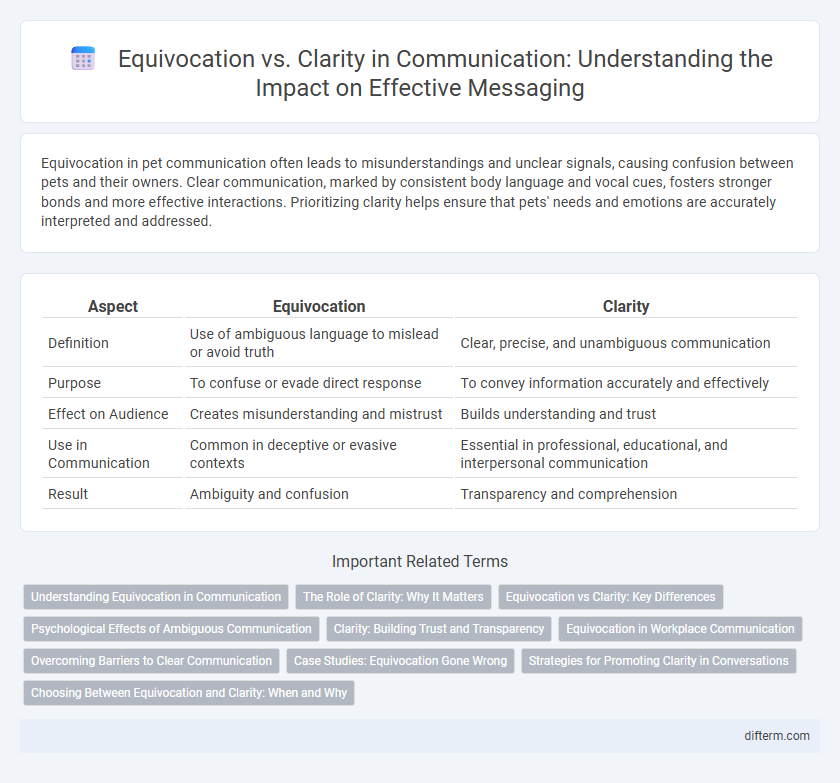Equivocation in pet communication often leads to misunderstandings and unclear signals, causing confusion between pets and their owners. Clear communication, marked by consistent body language and vocal cues, fosters stronger bonds and more effective interactions. Prioritizing clarity helps ensure that pets' needs and emotions are accurately interpreted and addressed.
Table of Comparison
| Aspect | Equivocation | Clarity |
|---|---|---|
| Definition | Use of ambiguous language to mislead or avoid truth | Clear, precise, and unambiguous communication |
| Purpose | To confuse or evade direct response | To convey information accurately and effectively |
| Effect on Audience | Creates misunderstanding and mistrust | Builds understanding and trust |
| Use in Communication | Common in deceptive or evasive contexts | Essential in professional, educational, and interpersonal communication |
| Result | Ambiguity and confusion | Transparency and comprehension |
Understanding Equivocation in Communication
Equivocation in communication involves using ambiguous language that obscures true intent, leading to misunderstandings and confusion. Clarity requires precise, straightforward language that conveys messages unambiguously and enhances comprehension. Prioritizing explicit communication reduces misinterpretation and fosters effective information exchange in personal and professional interactions.
The Role of Clarity: Why It Matters
Clarity in communication eliminates ambiguity, ensuring that messages are understood precisely and reducing the risk of misinterpretation. Equivocation, by contrast, introduces vagueness that can hinder effective decision-making and erode trust between communicators. Prioritizing clarity fosters transparency, enhances collaboration, and drives more productive interactions across professional and personal contexts.
Equivocation vs Clarity: Key Differences
Equivocation involves using ambiguous language that allows multiple interpretations, often leading to confusion or miscommunication. Clarity prioritizes precision and straightforwardness, ensuring the intended message is easily understood without ambiguity. Key differences include the intention behind word choice and the impact on audience comprehension, where equivocation obscures meaning while clarity enhances effective communication.
Psychological Effects of Ambiguous Communication
Ambiguous communication generates psychological stress by increasing uncertainty and anxiety in recipients, leading to decreased trust and impaired decision-making. Equivocation often causes cognitive overload as individuals struggle to interpret unclear messages, resulting in frustration and reduced engagement. Clear communication enhances mental clarity, fostering confidence and more effective interpersonal relationships.
Clarity: Building Trust and Transparency
Clarity in communication fosters trust by delivering precise and unambiguous messages that minimize misunderstandings. Transparent communication enhances credibility and strengthens relationships, ensuring all parties have a clear understanding of intentions and expectations. Prioritizing clarity promotes open dialogue, which is essential for effective collaboration and long-term trust-building.
Equivocation in Workplace Communication
Equivocation in workplace communication often leads to misunderstandings, decreased productivity, and eroded trust among team members. Vague language and ambiguous messages can cause confusion, resulting in errors and missed deadlines. Clear, direct communication is essential to ensure tasks are understood and collaborative efforts are effective.
Overcoming Barriers to Clear Communication
Equivocation creates confusion and misinterpretation that obstruct effective communication, making it essential to prioritize clarity by using precise language and concrete examples. Overcoming barriers to clear communication involves active listening, eliminating ambiguous terms, and encouraging open feedback to ensure mutual understanding. Consistent effort in refining message delivery enhances transparency and trust between communicators.
Case Studies: Equivocation Gone Wrong
Case studies on communication failures reveal how equivocation leads to costly misunderstandings in corporate settings, such as ambiguous contractual language causing prolonged legal disputes. In healthcare, unclear communication between medical staff resulted in critical errors during patient handoffs, highlighting the risks of vagueness. These examples emphasize the necessity of clarity and precision to ensure effective information exchange and avoid detrimental outcomes.
Strategies for Promoting Clarity in Conversations
Employing active listening and asking targeted questions helps minimize equivocation by ensuring accurate understanding in conversations. Using precise language and avoiding ambiguous terms enhances clarity and prevents misinterpretation. Structuring messages with clear, concise points supports focused communication and reinforces the intended meaning.
Choosing Between Equivocation and Clarity: When and Why
Choosing between equivocation and clarity hinges on the communication context and desired outcomes; clarity promotes transparency, trust, and efficient understanding, essential in professional and critical settings. Equivocation may be strategic in situations requiring diplomacy, confidentiality, or when information is incomplete, allowing for flexibility without committing to specifics. Understanding the audience's expectations and the stakes involved determines when ambiguity preserves relationships or clarity prevents misunderstandings.
equivocation vs clarity Infographic

 difterm.com
difterm.com